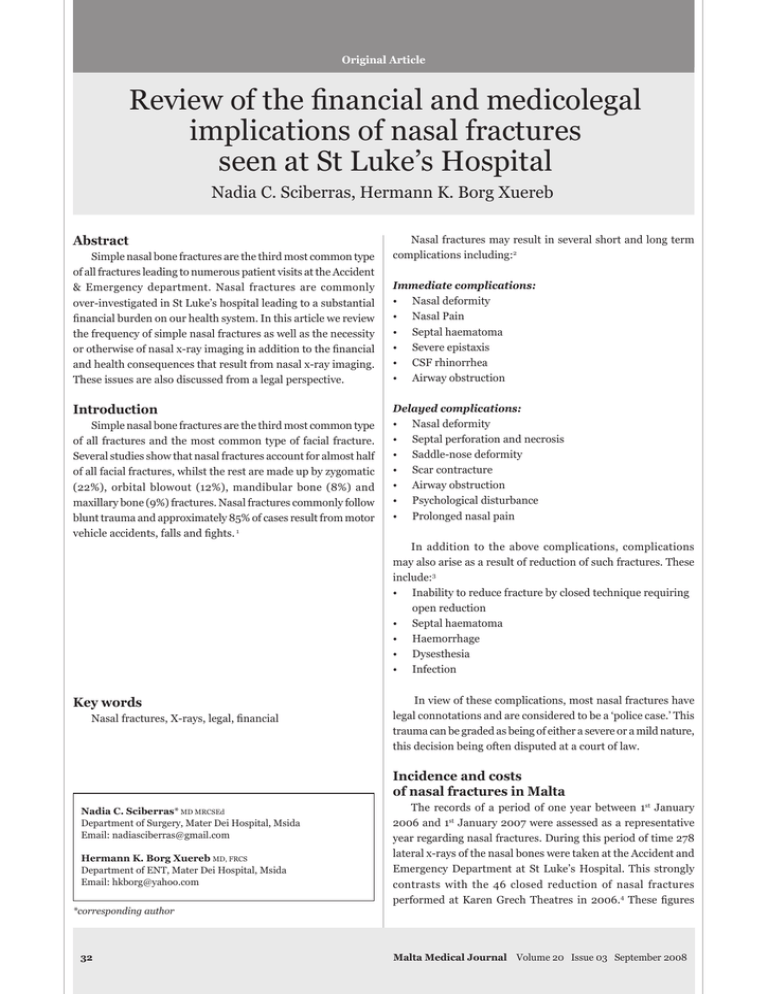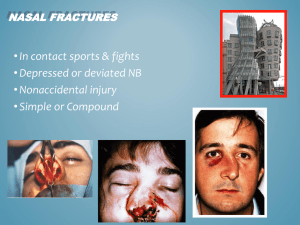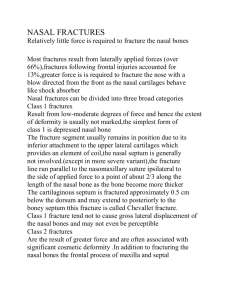Review of the financial and medicolegal implications of nasal fractures
advertisement

Original Article Review of the financial and medicolegal implications of nasal fractures seen at St Luke’s Hospital Nadia C. Sciberras, Hermann K. Borg Xuereb Abstract Simple nasal bone fractures are the third most common type of all fractures leading to numerous patient visits at the Accident & Emergency department. Nasal fractures are commonly over-investigated in St Luke’s hospital leading to a substantial financial burden on our health system. In this article we review the frequency of simple nasal fractures as well as the necessity or otherwise of nasal x-ray imaging in addition to the financial and health consequences that result from nasal x-ray imaging. These issues are also discussed from a legal perspective. Introduction Simple nasal bone fractures are the third most common type of all fractures and the most common type of facial fracture. Several studies show that nasal fractures account for almost half of all facial fractures, whilst the rest are made up by zygomatic (22%), orbital blowout (12%), mandibular bone (8%) and maxillary bone (9%) fractures. Nasal fractures commonly follow blunt trauma and approximately 85% of cases result from motor vehicle accidents, falls and fights. 1 Nasal fractures may result in several short and long term complications including:2 Immediate complications: • Nasal deformity • Nasal Pain • Septal haematoma • Severe epistaxis • CSF rhinorrhea • Airway obstruction Delayed complications: • Nasal deformity • Septal perforation and necrosis • Saddle-nose deformity • Scar contracture • Airway obstruction • Psychological disturbance • Prolonged nasal pain In addition to the above complications, complications may also arise as a result of reduction of such fractures. These include:3 • Inability to reduce fracture by closed technique requiring open reduction • Septal haematoma • Haemorrhage • Dysesthesia • Infection Key words Nasal fractures, X-rays, legal, financial In view of these complications, most nasal fractures have legal connotations and are considered to be a ‘police case.’ This trauma can be graded as being of either a severe or a mild nature, this decision being often disputed at a court of law. Incidence and costs of nasal fractures in Malta Nadia C. Sciberras* MD MRCSEd Department of Surgery, Mater Dei Hospital, Msida Email: nadiasciberras@gmail.com Hermann K. Borg Xuereb MD, FRCS Department of ENT, Mater Dei Hospital, Msida Email: hkborg@yahoo.com The records of a period of one year between 1st January 2006 and 1st January 2007 were assessed as a representative year regarding nasal fractures. During this period of time 278 lateral x-rays of the nasal bones were taken at the Accident and Emergency Department at St Luke’s Hospital. This strongly contrasts with the 46 closed reduction of nasal fractures performed at Karen Grech Theatres in 2006.4 These figures *corresponding author 32 Malta Medical Journal Volume 20 Issue 03 September 2008 show that the majority of patients that are examined for nasal trauma do not require any operative intervention under general anaesthesia. At the time of writing the price per small x-ray film is €0.98 (Lm0.42) with a total expenditure for the year of €272.20 (Lm116.76). This does not take into consideration the expense of the development and fixing of the film, the maintenance of the x-ray machine and the labour costs. The same investigation in the private sector is charged at €76.93 (Lm33.00). If this is used as an estimate of the true cost of a nasal x-ray investigation, this would result in a total expenditure of €21,384.39 (Lm9,174.00), though one must consider the element of profit in the private sector. At the Mater Dei hospital the x-rays are to be fully digitalized with a consequent change in the fee per investigation. Health and safety The radiological dose per lateral nasal film is 40Kv and 1.2 Mas. In paediatric cases the mother needs to accompany the child during taking of the x-ray thereby exposing her to radiation. If the young patient moves, a second x-ray will have to be taken doubling the dose to both mother and child. The calculated surface dose to the eye for a ‘normal’ adult would be approx 0.02 mGy. This is about 1000 times lower than the threshold for an opacity/cataract, and accordingly there is no possible cumulative effect or any possibility of damaging the eyes. Thus there are no real safety implications involved when taking a nasal bone x-ray because of the low doses and the lack of radiosensitive material in the head. However, with regards to the medical exposure of ionizing radiation, the Public Health Act (2003) states that: 5 7 (1) No practitioner may authorise a medical exposure unless he has given due consideration to: (a) the specific objectives of the exposure and the characteristics of the individual involved; (b) the target volumes intended for radiotherapeutic purpose which volumes are individually planned taking into account the doses of non-target volumes and tissues shall be as low as practicable and consistent with the intended radiotherapeutic purpose of the exposure; (c) the total potential diagnostic benefits or the total therapeutic benefits it produces; (d) the direct health benefits to the individual and the benefits to society; (e) the individual detriment that the exposure may cause; (f) the efficacy, benefits and risks of available alternative techniques having the same objectives but involving no or less exposure to ionizing radiation. Malta Medical Journal Volume 20 Issue 03 September 2008 Figure 1: Swollen, bruised and deformed nose following nasal injury Diagnosis and the usefulness of radiological investigation The diagnosis of a nasal fracture has great medico-legal implications. However, from the medical point of view it is important to reach a balance between the legal obligations and the over-investigation of a patient with an uncomplicated nasal injury. The diagnosis of a nasal fracture is clinical and the management depends entirely on the clinical findings. Thus a thorough history and examination are necessary. The history should include: • Mechanism of injury • Pre-existing nasal deformities • Previous history of nasal airway obstruction • Previous history of any degree of loss of smell (hypo/ anosmia) • Prior nasal allergies, sinusitis or nasal septal surgery The nose should be examined both externally and internally. External examination of the nose may show: • Swelling • Nasal deformity • Crepitus • Mobility of fractured bones • Nasal airway obstruction • Epistaxis – signifying mucosal disruption thereby increasing the suspicion of a nasal or septal fracture. • Skin lacerations • Infraorbital ecchymosis On performing an internal examination one should carefully exclude any septal haematoma or septal deviation. However a septal deviation does not automatically signify the presence of a fracture as 33-50% of the population normally has a septal defect arising from various causes.6 According to the European Union referral guidelines for imaging, plain x-rays for isolated nasal fractures are rarely 33 indicated and should not be performed routinely unless requested by a specialist. 7 Nasal x-rays are likely to miss nearly 50% of nasal fractures whilst old fractures, vascular markings and suture lines can lead to false-positive results. In addition, cartilaginous injury is not detected radiologically. In a prospective study conducted by Logan et al at St Vincent’s Hospital, Ireland, a true-positive rate of 86% and a falsepositive rate of 8% were reported.8 Another study conducted by de Lacey et al showed that 66% of control subjects had a false-positive x-ray diagnosis using Waters (occipitomental) view radiographs.9 All nasal injuries are followed-up within a week of the injury when the oedema would have resolved. If a deformity persists, then nasal x-rays are taken to help plan the repair. Such a management not only protects most patients from unnecessary radiation but is also very cost-effective since most nasal fractures do not need to be reduced. Legal background Medical experts at times need to seek legal advice in order to establish what should be considered as grievous bodily harm (natura gravi) or slight bodily harm (natura ˙afifa). Unfortunately legal experts may have different interpretation of the Criminal Code of Malta. Thus at times, the same clinical nasal fracture can be labelled differently by different medical experts. Article 214 of the Criminal Code of Malta speaks of who is guilty of bodily harm: 214. Whosoever, without intent to kill or to put the life of any person in manifest jeopardy, shall cause harm to the body or health of another person, or shall cause to such other person a mental derangement, shall be guilty of bodily harm.10 Articles 215 to 221 deal with what constitutes a grievous or slight bodily harm and with their punishment according to the nature of the injury and the means with which it was produced. 215. A bodily harm may be either grievous or slight. 216. (1) A bodily harm is deemed to be grievous and is punishable with imprisonment for a term from three months to three years – (a)if it can give rise to danger of (i) loss of life; or (ii) any permanent debility of the health or permanent functional debility of any organ of the body; or (iii) any permanent defect in any part of the physical structure of the body; or (iv) any permanent mental infirmity; (b) if it causes any deformity or disfigurement in the face, neck, or either of the hands of the person injured; 34 (c) if it is caused by any wound which penetrates into one of the cavities of the body, without producing any of the effects mentioned in article 218; (d) if it causes any mental or physical infirmity lasting for a period of thirty days or more; or if the party injured is incapacitated, for a like period, from attending to his occupation; (e) if, being committed on a woman with child, it hastens delivery. (2) Where the person injured shall have recovered without ever having been, during the illness, in actual danger of life or of the effects mentioned in subarticle (1)(a), it shall be deemed that the harm could have given rise to such danger only where the danger was probable in view of the nature or the natural consequences of the harm. 221. (1) A bodily harm which does not produce any of the effects referred to in the preceding articles of this subtitle, shall be deemed to be slight, and shall be punishable with imprisonment for a term not exceeding three months, or with a fine (multa). (2) Where the offence is committed by any of the means referred to in article 217, it shall be punishable with imprisonment for a term from two months to one year. (3) Where the effect, considered both physically and morally, is of small consequence to the injured party, the offender shall, on conviction, be liable to (a) imprisonment for a term not exceeding three months or a fine (multa), if the offence is committed by any of the means referred to in article 217, or is committed on any of the persons mentioned in article 222(1)(a) and (b); (b) the punishments established for contraventions, in any other case. (4) In the cases referred to in subarticles (1) and (3), proceedings may not be taken except on the complaint of the injured party, unless the offence is committed on any of the persons mentioned in article 222(1)(a) and (b). In accordance with the Maltese Law, any nasal fracture resulting in nasal deformity or nasal obstruction should be considered as grievous bodily harm. The status of the injury does not change with any subsequent treatment that the patient is given even if this results in correction of the deformity. Indeed a nasal injury need not involve a fracture for it to be considered as grievous bodily harm. Any injury that results in lacerations that will leave a scar on the nose (and hence the face) or that results in psychological effects lasting more than 30 days should be considered to be an act of grievous bodily harm. As nasal fracture healing in healthy adults occurs in approximately 3 weeks, uncomplicated nondisplaced fractures are considered to be of slight bodily harm.6 However consideration should be given to the fact that bone remodelling follows fracture healing and this process may last for up to several months. Malta Medical Journal Volume 20 Issue 03 September 2008 Conclusions Acknowledgements In view of the poor correlation between radiological findings and the presence of external deformity, patients attending the Accident & Emergency Department with nasal trauma should not routinely have radiological examinations unless requested by a specialist even though the Maltese Law considers any nasal fracture resulting in nasal deformity or nasal obstruction as grievous bodily harm. Indeed a thorough history and examination is all that is needed to diagnose a nasal fracture. Patients that have uncomplicated nondisplaced fractures heal spontaneously without needing any operative intervention whilst operative interventions performed in those with complicated fractures are performed according to the amount of deformity rather than according to nasal x-ray examination. Over-investigation is as bad as under-investigation and consequently patients can sue the medical professional performing unnecssary dangerous investigations that may effect their health. Indeed the medical profession is based on the ‘first do no harm’ principle. Abolishing unnecessary investigations would allow a better re-allocation of the funds within the health system thereby allowing an improvement in the health system with a superior service being offered to the patient. • • Malta Medical Journal Volume 20 Issue 03 September 2008 • Insp Dr Mary Muscat LLD Cert Crim, Dip Policing, PG Dip Env Mgt, BA, BA(Hons), MSc (Port) Mr Edward Gruppetta BSc Hons, PGC (Radiation Protection), SRR, Qualified Expert – Diagnostic Radiology, Radiation Protection and Safety Co-Ordinator - Radiology Department. Mr Joseph Vassallo - Radiology Department References 1. Muraoka M, Nakai Y: Twenty years of statistics and observation of facial bone fracture. Acta Otolaryngol Suppl. 1998; 538:261-5. 2. Mondin V, Rinaldo A, Ferlito A: Management of nasal bone fractures. Am J Otolaryngol 2005; 26: 181-5. 3. Mayorga O, Steele N, Fried M: Nasal Fracture Reduction. Emedicine June 2006. Available from http://www.emedicine. com/proc/topic82831.htm. 4. Clinical Performance Management Unit, SLH: Surgical Operations Report: Annual Report 2006: 7. 5. The Public Health Act: The Ionising Radiation Medical Exposure Regulations 2003 (Act No. XIII of 2003). Government Gazette Supplement 2003: 17,522 available from http://www.parliament. gov.mt/information/Papers/0958.pdf. 6. Haraldson S, Reinbolt R, Welch R: Nasal Fracture. Emedicine September 2006. Available from http://www.emedicine.com/ sports/topic84.htm. 7. European Commission Directorate-General for the Environment: Referral guidelines for imaging.2000. 8. Logan M, O’Driscoll K, Masterson J. The utility of nasal bone radiographs in nasal trauma. Clin Radiol 1994 Mar; 49: 192-4. 9. de Lacey GJ, Wignall BK, Hussain S, Reidy JR: The radiology of nasal injuries: problems of interpretation and clinical relevance. Br J Radiol 1977; 50: 412-4. 10.Laws of Malta: Criminal Code, Chapter 9 Articles 214-221:81-83 (June 1854). 35





